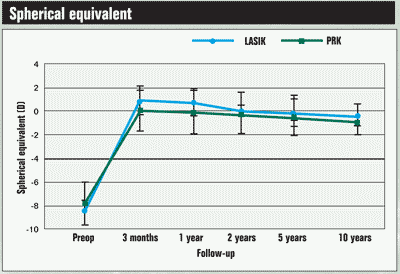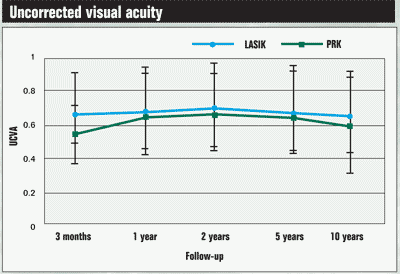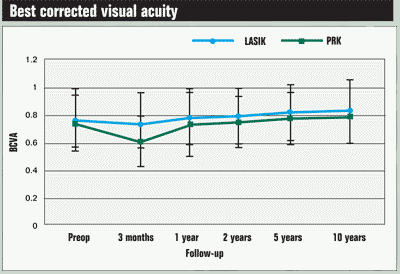PRK, LASIK found stable at 10 years in large series
Efficacy, safety and predictability were maintained throughout the study in eyes with low, intermediate and high myopia.
 Jorge L. Alió |
LONDON – PRK and LASIK outcomes were predictable, safe and stable in a large series of patients followed for 10 years, according to a speaker here.
At the European Society of Cataract and Refractive Surgeons meeting, Jorge L. Alió, MD, PhD, presented 10-year results of PRK and LASIK in 800 eyes treated for myopia or myopic astigmatism at his clinic in Alicante, Spain. He said the good results of this long-term follow-up study are evidence of the stability of the two refractive surgical procedures.
Dr. Alió acknowledged concerns regarding complications of both procedures, such as haze and regression after PRK and corneal ectasia, dry eye, and irregular and dislocated flaps after LASIK.
“When we have all these lists of complications and the millions of cases that have been operated, it is astonishing that we have very few [published] reports dealing with more than 100 cases for longer than 5 years,” he said.
Dr. Alió’s study, funded by the Spanish government, included 500 eyes treated with PRK for a mean spherical equivalent of –6.5 D and 300 eyes treated with LASIK for a mean spherical equivalent of –11.8 D. All procedures were performed with the Visx Twenty/Twenty excimer laser, manufactured by Visx before that company’s acquisition by Advanced Medical Optics.
No re-treatments were performed beyond 6 months postoperatively, and the patients were followed up at 3 months and 1, 2, 5 and 10 years, he said.
Overall results showed that after 10 years, PRK had a safety index of 1 and an efficacy index of 1.7. LASIK had a safety index of 1.17 and an efficacy index of 0.83, he said.
“No statistically significant difference was found between both procedures … in the predictability, safety, efficacy and corneal stability,” Dr. Alió said.
Complications after PRK included 10 central islands, four cases of corneal leukoma and two corneal ulcers. Complications after LASIK included 13 corneas with epithelial problems, eight cases of moderate corneal melting, six cases with symptomatic ocular surface syndrome, four cases of severe corneal striae and two cases of corneal scarring at the interface.
Three cases of corneal ectasia were seen in the LASIK group, but Dr. Alió explained that these occurred before current standards and indications for LASIK had been developed.
“Ectasia was not detected in any case or as a trend,” he said.
   Source: Alió JL |
Low myopia outcomes
For the data analysis, the investigators divided the eyes into three groups according to their severity of myopia.
The low myopia group included 228 eyes treated with PRK and 21 eyes treated with LASIK, Dr. Alió said. Low myopia was defined as spherical equivalent of less than –6 D.
In the low myopia group, PRK had a 4% retreatment rate and LASIK had a 14% retreatment rate.
The predictability outcomes for low myopia showed that in the PRK group, 68% of eyes were within ±0.5 D of emmetropia and 83% were within ±1 D of emmetropia. In the LASIK group, 48% of eyes were within ±0.5 D of emmetropia and 76% were within ±1 D of emmetropia.
The efficacy index was 0.89 for LASIK and 0.82 for PRK, and the safety index was 1.06 for LASIK and 1.03 for PRK, Dr. Alió said, noting that these numbers reflected the full 10-year evolution of the study.
Keratometry for both groups showed good corneal stability throughout the entire 10-year follow-up.
Intermediate myopia
The intermediate myopia group included 195 eyes treated with PRK and 80 treated with LASIK. Intermediate myopia was defined as spherical equivalent between –10 D and –6 D.
The rates of retreatment (which was only performed once) were 29% for PRK and 25% for LASIK.
Predictability for the PRK group showed 51% of eyes were within ±0.5 D of emmetropia and 69% were within ±1 D. In the LASIK group, 66% were within ±0.5 D of emmetropia and 67% were within ±1 D of emmetropia.
The efficacy indexes were 0.89 for LASIK and 0.78 for PRK, and the safety indexes were 1.11 for LASIK and 1.02 for PRK.
Corneal keratometry showed that both groups had good corneal stability through the duration of the study, Dr. Alió said.
“The evolution of the uncorrected visual acuity and best corrected visual acuity were very good in both groups,” he said.
High myopia outcomes
Eyes with high myopia, defined as more than –10 D, included 71 PRK eyes and 196 LASIK eyes, he said.
According to the results, the re-treatment rate was 51% for PRK eyes and 27% for LASIK eyes.
Predictability data for the PRK group showed that 53% of eyes were within ±0.5 D of emmetropia and 59% were within ±1 D of emmetropia. In the LASIK group, 35% of eyes were within ±0.5 D of emmetropia and 49% of eyes were within ±1 D of emmetropia.
The efficacy index was 0.79 for the LASIK group and 0.76 for the PRK group. The safety index was 1.21 in the LASIK group and 1.12 in the PRK group, the results showed.
Corneal keratometry showed good corneal stability, Dr. Alió said.
Conclusions reflect earliest refractive surgery
In the end, both procedures demonstrated high predictability in low myopia, Dr. Alió said, although PRK showed a trend toward better predictability than LASIK.
LASIK showed better predictability and safety in intermediate and high myopia, he said.
“More refractive procedures show good stability and good results 10 years after the surgery,” Dr. Alió said.
Putting the results into context, Dr. Alió explained to Ocular Surgery News during a telephone interview that with the latest advances in refractive surgery such as transition zones, tissue saving algorithms and energy saving lasers taking hold, results from LASIK and PRK are only going to improve.
“Our technology and our technique now is not comparable to what we had back then,” Dr. Alió said. “At that time, we had only one microkeratome with a biased way to use the blades, often with an inadequate calibration of the instruments, and with many issues that made, in my opinion, a negative impact on the procedure. Even in this environment, LASIK was very successful.
“I think that we have learned that if that was true then, today it is going to be even better,” he continued.
Limited complications
Though the primary purpose of the study was to assess refractive outcomes and stability, Dr. Alió noted that the results reflected a good profile for complications such as dry eye or ocular surface syndrome.
“All these possible complications affected the early postop but not the late postop,” he said. “The patients were very well refracted and very well sighted.”
Corneal ectasia only occurred in cases of high myopia, and that was due not only to antiquated techniques and tools but to a less stringent patient selection and limited knowledge of corneal topography, according to Dr. Alió.
“We were operating with myopia up to 20 D with this technique, something that would be impossible now,” he told Ocular Surgery News. “We were stretching the limits of corneal refractive surgery with very minimal complications and stability.”
Regression and corneal biomechanics
Future data concerning topographical changes in the corneas of these patients will be presented at future meetings, Dr. Alió told Ocular Surgery News, but he briefly explained that long-term regression was not an issue in these patients.
According to Dr. Alió there was a trend toward an increased myopia of 0.75 D at 10 years in the intermediate and high myopia groups, but this was a result of the natural course of myopia.
“In the biomechanical study we performed, topography changes have not been evident,” he said. “Changes in refraction in myopes are to be expected because this is normal in the life of myopes.”
Other refractive options such as surface ablation have been gaining popularity due primarily to lower cost, but Dr. Alió said LASIK provides the best outcomes.
“There is no substantial evidence to support that surface ablation is better in terms of refraction,” he said. “In my opinion, LASIK is the way to go, and surface ablation is just for selected cases.”
For more information:
- Jorge L. Alió, MD, PhD, can be reached at Vissum, Instituto Oftalmológico de Alicante, Avda. de Denia, s/n, 03016 Alicante, Spain; +34-965-150-025; fax: +34-965-151-501; e-mail: jlalio@vissum.com.
- Jared Schultz is an OSN Staff Writer who covers all aspects of ophthalmology. He focuses geographically on Europe and the Asia-Pacific region.
